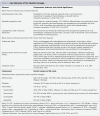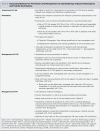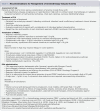Myeloid toxicity of cancer treatment
- PMID: 25031949
- PMCID: PMC4093344
Myeloid toxicity of cancer treatment
Abstract
Myelotoxicity is one of the most common treatment-related adverse events for patients receiving systemic antineoplastic therapy or radiotherapy to bone marrow-producing regions. Myeloid cytopenias, including neutropenia, thrombocytopenia, and anemia, are the most common manifestations of treatment-related myelotoxicity and one of the most common reasons for dose modifications, dose delays, or discontinuation of therapy, potentially limiting therapeutic benefit. Risk factors for myelotoxicity can be broadly categorized into three types: disease-related, host-related, and treatment- related. Familiarity with factors predictive of high-risk febrile neutropenia, bleeding due to thrombocytopenia, and cardiopulmonary compromise due to anemia will provide the advanced practitioner (AP) in oncology with critical tools for rapid identification of patients at risk, prompt implementation of established guidelines for management, and avoidance of clinical deterioration. The AP in oncology is often the primary point of contact for management of cytopenias, including administration of myeloid growth factors, transfusion of blood products, and management of acute events such as neutropenic fevers. Each of these interventions requires familiarity with the risk and benefits of treatment. This article will review the physiology of the bone marrow, risk factors for cytopenias, and current guidelines and recommendations for prevention and treatment of myeloid toxicity of cancer treatment.
Figures









References
-
- Aapro M. S., Bohlius J., Cameron D. A., Dal Lago L., Donnelly J. P., Kearney N., Zielinski C. 2010 update of EORTC guidelines for the use of granulocyte-colony stimulating factor to reduce the incidence of chemotherapy-induced febrile neutropenia in adult patients with lymphoproliferative disorders and solid tumors. European Journal of Cancer. 2011;47:8–32. - PubMed
-
- Ahn S., Lee Y. S. Predictive factors for poor prognosis febrile neutropenia. Current Opinion in Hematology. 2012;24:376–380. - PubMed
-
- Barr P. J., Donnelly M., Cardwell C. R., Parker M., Morris K., Bailie K. E. The appropriateness of red blood cell use and the extent of overtransfusion: Right decision? Right amount? Tranfusion. 2011;51:1684–1694. - PubMed
Publication types
LinkOut - more resources
Full Text Sources
Other Literature Sources
